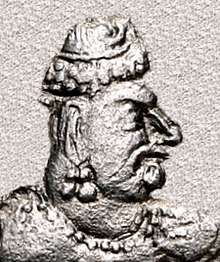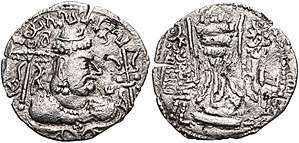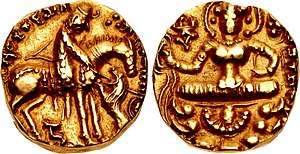Toramana
| Toramana | |
|---|---|
| Tegin of the Alchon Huns | |
 Portrait of Toramana. | |
| Reign | 493-515 |
| Predecessor | Mehama |
| Successor | Mihirakula |

Toramana was a ruler of the Alchon Huns who ruled its Indian region in the late 5th and the early 6th century.[1] Toramana consolidated the Hephthalite power in Punjab (present-day Pakistan and northwestern India), and conquered northern and central India including Eran in Madhya Pradesh.
The Sanjeli inscription of Toramana speaks of his conquest and control over Malwa and Gujarat. His territory also included Uttar Pradesh, Rajasthan and Kashmir.[2]
According to the Rīsthal inscription, discovered in 1983, the Aulikara king Prakashadharma of Malwa defeated him.[3]
Overview
Toramana is known from Rajatarangini, through coins and inscriptions.
Punjab inscription
In the Kura inscription (495-500, in the Salt Range in Punjab), Toramana assumes the Indian regnal title Rajadhiraja Maharaja Toramana Sahi Jaukha.[4]
Gwalior inscription of Mihirakula

In the Gwalior inscription of Mihirakula, from Gwalior in northern Madhya Pradesh, India, and written in Sanskrit, Toramana is described as:
"A ruler of [the earth], of great merit, who was renowned by the name of the glorious Tôramâna; by whom, through (his) heroism that was specially characterized by truthfulness, the earth was governed with justice."
Eran Boar inscription


The Eran Boar inscription (in Eran, Malwa, 540 km south of New Delhi, state of Madhya Pradesh) of his first regnal year indicates that eastern Malwa was included in his dominion. The inscription is written on the neck of the boar, in 8 lines of Sanskrit in the Brahmi script. The object of the inscription is to record the building of the temple in which the current Varaha image stands, by Dhanyavishnu, the younger brother of the deceased Maharaja Matrivishnu.[5] The first line of the inscription, made after 484/85 CE mentions the "Maharajadhiraja Toramana" ("The great king of king Toramana")[4] and reads:
"In year one of the reign of the King of Kings Sri-Toramana, who rules the world with splendor and radiance...."
Sack of Kausambi
The presence of seals in the name of "Toramana" and "Hunaraja" in Kausambi, suggests that the city was probably sacked by the Alkhons under Toramana in 497-500.[4][7][8][9]
Defeats


According to the Rishtal stone-slab inscription, discovered in 1983, the Aulikara king Prakashadharma of Malwa defeated him in 515 CE.[12][4]
Toramana may also have been defeated by the Indian Emperor Bhanugupta of the Gupta Empire in 510 A.D. according to the Eran inscription, although the "great battle" to which Bhanagupta participated is not explicited.[13][14][15]
A few silver coins of Toramana closely followed the Gupta silver coins. The only difference in the obverse is that the king's head is turned to the left. The reverse retains the fantailed peacock and the legend is almost similar, except the change of name to Toramana Deva.[16][17]
A Jaina work of the 8th century, the Kuvalayamala states that he lived in Pavvaiya on the bank of the Chandrabhaga and enjoyed the sovereignty of the world.[18]
Successor
Toramana was succeeded by his son Mihirakula.[19]
See also
Notes
- ↑ Grousset, Rene (1970). The Empire of the Steppes. Rutgers University Press. pp. 70–71. ISBN 0-8135-1304-9.
- ↑ Dani, Ahmad Hasan (1999). History of Civilizations of Central Asia: The crossroads of civilizations, A.D. 250 to 750. Motilal Banarsidass Publ. p. 142. ISBN 8120815408. Retrieved November 5, 2012.
- ↑ Ojha, N.K. (2001). The Aulikaras of Central India: History and Inscriptions, Chandigarh: Arun Publishing House, ISBN 81-85212-78-3, pp.48-50
- 1 2 3 4 Hans Bakker 24th Gonda lecture
- ↑ Fleet (1888)
- ↑ Coin Cabinet of the Kunsthistorisches Museum Vienna
- ↑ Indian History, Allied Publishers p.81
- ↑ Dynastic History of Magadha, Cir. 450-1200 A.D., by Bindeshwari Prasad Sinha p.70
- ↑ Geography from Ancient Indian Coins & Seals, by Parmanand Gupta p.175
- ↑ CNG Coins
- ↑ The Identity of Prakasaditya by Pankaj Tandon, Boston University
- ↑ Ojha, N.K. (2001). The Aulikaras of Central India: History and Inscriptions, Chandigarh: Arun Publishing House, ISBN 81-85212-78-3, pp.48-50
- ↑ Archaeological Excavations in Central India: Madhya Pradesh and Chhattisgarh, by Om Prakash Misra p.7
- ↑ Encyclopaedia of Indian Events & Dates by S. B. Bhattacherje A15
- ↑ The Classical Age by R.K. Pruthi p.262
- ↑ Gupta, P.L. (2000). Coins, New Delhi: National Book Trust, ISBN 81-237-1887-X, p.78
- ↑ The Identity of Prakasaditya by Pankaj Tandon p.661, with photograph
- ↑ Mahajan V.D. (1960, reprint 2007). Ancient India, S.Chand & Company, New Delhi, ISBN 81-219-0887-6, p.519
- ↑ "Gwalior Stone Inscription of Mihirakula" (PDF). Project South Asia. Archived from the original (PDF) on 12 August 2011. Retrieved 5 April 2009.
| Preceded by Khingila I |
Tegin of the Alchon Huns | Succeeded by Mihirakula |